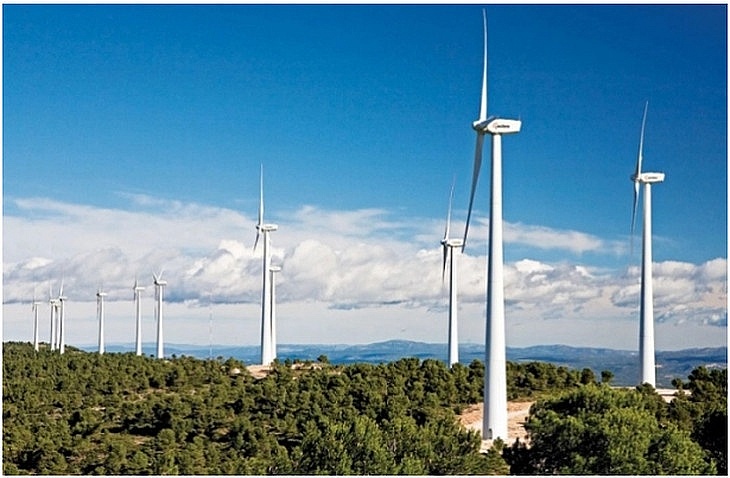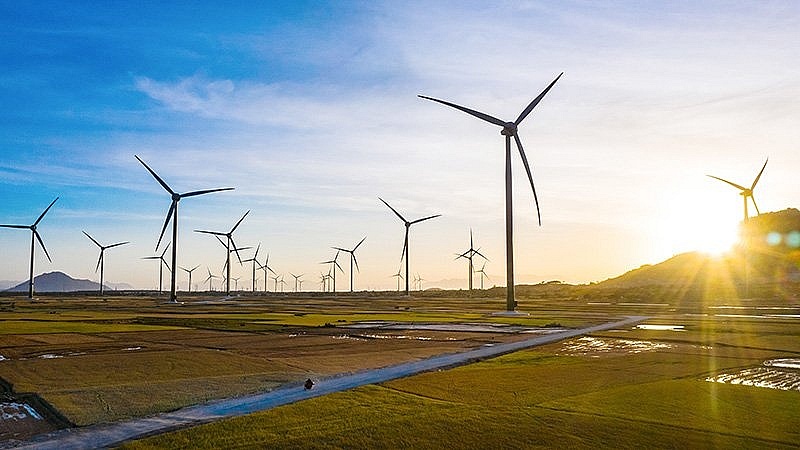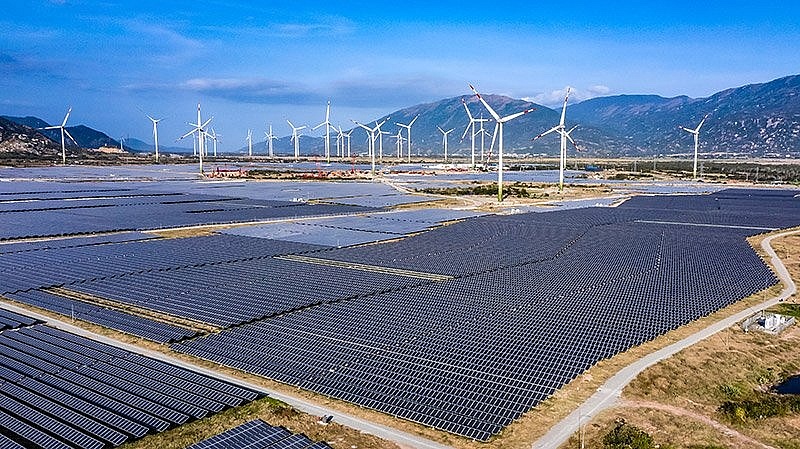Green energy development a long-term orientation in Vietnam
 |
Vietnam is making efforts to realise Prime Minister Pham Minh Chinh’s commitment at COP26 to achieve net zero emissions by 2050.
To this end, the Ministry of Industry and Trade (MoIT) updated Vietnam's Power Development Plan VIII (PDP 8) towards strongly reducing coal-fired power; developing gas-fired power generation; and increasing the capacity of renewable energy sources while also boosting economic and efficient energy usage.
Prioritising clean energy development
At a meeting with Alok Kumar Sharma, president at COP26 at the headquarters of the MoIT in February 2022, Minister Nguyen Hong Dien said that the ministry has been working to update the draft Power Development Plan VIII.
“In the draft Power Development Plan VIII, renewable energy in the power structure, especially wind will significantly increase. By 2030, the total capacity of electricity sources using renewable energy sources (exclude hydropower) is expected to reach 38 GW, making up 24 per cent. The threshold in developed countries like the US is recently about 14-15 per cent.” Dien added.
"By 2045, the total capacity of renewable energy (excluding hydropower) is expected to rise to about 56GW, accounting for 45 per cent of the country’s power structure.”
 |
As of the end of 2021, the total capacity of renewable energy was 20,670MW, making up 27 per cent of the country’s total (76,620 MW). Total electricity output from renewable energy sources was 31.508 billion kWh, accounting for 12.27 per cent of the country’s total output.
Vietnam already has 70 wind-to-power projects with a capacity of 3,987MW, producing a total of 3.34 billion kWh in 2021, accounting for 1.3 per cent of the country’s total output.
The total solar power output in 2021 made up about 10.8 per cent of the total. The installed capacity of biomass and garbage electricity was 321MW as of October.
At the meeting of the Vietnam Energy Partnership Group held in Hanoi in January, Deputy Minister of Industry and Trade Dang Hoang Anh emphasised that the government determines to implement sustainable energy transition by developing internal resources and intensifying cooperation and support from partners.
According to the deputy minister, Vietnam boasts huge potential for the development of green, clean energy thanks to favourable natural conditions and the government’s long-term orientations.
The restructuring of the energy sector is accelerated together with the restructuring of state-owned enterprises to increase their operational efficiency towards promoting equitisation and divesting state stakes, as well as developing a competitive power market in line with the approved roadmap. Moreover, Vietnam is also implementing the national target programme on energy efficiency.
In addition to the advantages, Vietnam is taking a number of solutions to solve the difficulties in ensuring energy security, while mitigating environmental impacts from energy generation. A high electricity load growth puts pressure on the energy industry's infrastructure, requiring huge capital amid increased public debt and a slow equitisation process.
Therefore, the strategy on long-term sustainable energy development in alignment with reality plays a key role in the country’s energy development orientation.
In this context, Resolution No.55-NQ/TW of the Politburo was issued in 2020, showing the Party’s orientation of the national energy development strategy by 2030, with a vision towards 2045.
In addition, the MoIT is concretising its energy development strategy by building and completing the draft PDP 8 and Vietnam’s coal industry development strategy. These are important plans, creating a foundation to promote the development of the energy industry.
Towards implementing the COP26 commitments
 |
To achieve the net zero commitment by 2050, Vietnam aims to boost international cooperation and call for the considerable support from international development organisations and the private sector, including private businesses, non-government organisations, and research institutes.
Dr. Ngo Duc Lam, an independent energy expert and former head of the Institute of Energy, said the wind power price will strongly reduce.
"Over the past three years, renewable energy accounted for over 20 per cent of the installed capacity of the whole network. The rate is expected to reach 45-50 per cent by 2050," Lam elaborated.
However, greenhouse gas emissions not only come from thermal power but also from other industries which burn a lot of coal. Agriculture is also a contributor to greenhouse gas emissions.
In addition to industries that produce greenhouse gas emissions, Vietnam also has methods to mitigate emissions from being discharged into the environment, such as afforestation. Forests absorb CO2, so afforestation is crucial to counteract emissions.
According to experts, renewable energy to mitigate greenhouse gas emissions mainly comes from wind power and solar energy. Solar power helps reduce greenhouse gas emissions, but it causes some challenges for the power network as it can only work during the daytime.
What the stars mean:
★ Poor ★ ★ Promising ★★★ Good ★★★★ Very good ★★★★★ Exceptional
Themes: Towards Sustainability
Related Contents
Latest News
More News
- Efficient technology solutions key factors in energy transition (September 25, 2024 | 09:00)
- Sao Do Group gears towards energy savings (December 07, 2023 | 12:01)
- Vice President Vo Thi Anh Xuan visits Copenhagen Infrastructure Partners headquarters (November 23, 2023 | 10:37)
- A wind turbine tower collapses in China (November 20, 2023 | 19:36)
- Vietnam has massive potential for offshore wind energy (March 17, 2023 | 16:29)
- Rooftop solar event entices EPC contractors and investment funds (March 09, 2023 | 07:50)
- GreenYellow acquires 49.5MWp solar farm of French IPP Qair in Vietnam (November 25, 2022 | 08:00)
- Eaton contributes to Vietnam’s low-carbon economy (November 20, 2022 | 19:00)
- Proposals to promote Vietnam's energy transition (November 12, 2022 | 22:02)
- How intelligent lights make cities smarter, safer and greener (November 04, 2022 | 09:00)

 Tag:
Tag:
























 Mobile Version
Mobile Version